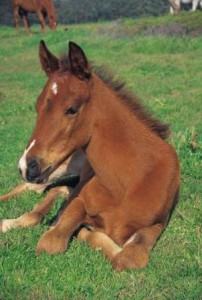Control Flies Around Horses
Finally, those long, cold winter months are far behind us and we are now able to go outside and enjoy the fresh sunshine and warm spring days. We’ve packed up our winter gear and put away the heavy blankets, and before we know it we’ll be replacing them with fly sheets and fly masks. That’s because warm weather means that those pesky flies, mosquitoes and gnats will soon be out in full force. And then once again, the annual ritual will begin… the battle of trying to control flies around horses and in the barn area. So here’s the good news: we have some easy tips for you to effectively control the fly population before it becomes a bigger problem.
The most successful strategy to control flies around horses is to start early in the season and continue the battle throughout the entire season, making sure you diligently combat the flies during all stages of their life cycle. Typically most flies develop from the egg stage to the adult stage in as little as 2-4 weeks and adult flies have an average life span of 3-4 weeks. And depending on environmental conditions, such as wet dark areas, this life cycle can accelerate very quickly! So it’s important to keep the fly population under control not only because these pests are extremely annoying to both you and your horse, but they can also spread diseases such as West Nile Virus, Lyme disease, or encephalitis.
EFFECTIVE FLY CONTROL TIPS:
Step 1 – Fly Prevention
One of the most effective ways to control flies around horses starts with keeping a clean environment. An average 1000 pound horse generates 50 pounds of manure daily, so it’s essential that you remove the manure from the stalls as quickly as possible. Flies thrive on moist manure piles and wet shavings, so the cleaner and drier your horse’s stalls are, the better your chances will be in keeping the fly population under control.
Once you’ve removed the manure from the stalls, make sure you store it away from your barn area. If complete waste disposal is not possible and you deposit the manure in fields, make it a regular practice to drag the fields and distribute the manure evenly in thin layers so that it can dry quickly. Flies cannot complete their full life cycles in dry environments, so if you can spread the manure thinly and evenly, this will also help to control the fly population.
Flies also like to congregate around water buckets and feeding troughs, so it’s important to thoroughly clean the water buckets and feed troughs regularly. Try to remove and eliminate any areas of standing water or puddles as these are especially popular breeding areas for both flies and mosquitoes. Also, keep your horse’s feed (especially sweet feed) tightly sealed and stored in dry storage containers where it cannot be reached by flies and other insects.
Step 2 – Fly Reduction
There are a wide variety of products available that you can use to help to control flies around horses. Hanging disposable fly traps are very popular as well as effective – these traps can reportedly catch up to 20,000 flies! Each trap contains a small bag of fly attractant that dissolves when water is added to the trap. Flies are then lured by the scent and enter the trap through the openings at the top of the bag. Hanging fly sticks and fly paper are also very popular and inexpensive choices. Fly paper, which is is available in a variety of sizes and widths, may have attractants that you can sprinkle on top while other types are just plain sticky. Depending on your barn design, you can either hang them from the ceiling or near the top of the stalls, or you can also hang them in common areas or across tall doorways.
Automatic horse fly spray systems are another effective method used to control flies around horses. This type of fly control system is very popular in large barns or riding facilities since it can easily provide coverage across large areas. The system works by using an electric motor-driven pump that is controlled by a timer that you can program based on your individual barn needs and preferences. Once programmed, a fine mist of insecticide is then sprayed through small nozzles in and around the barn area. The best part is that it’s easy since it is automatic and can be adjusted for day or night insect control.
The use of fly predators is another method used by many people to keep the fly population under control. Fly predators are tiny nocturnal stingless wasps that lay their eggs in the fly pupa, so the pupa never develops into a fly. Fly predators are most effective if released early in the season and then re-released every few weeks afterwards. The success of using fly predators depends on the number of fly predators released and the severity of the fly population. If you decide to use fly predators, remember that you will not be able to use spray insecticides since this will eliminate the fly predators along with the flies.
Step 3 – Protect Your Horse
Fly masks are an effective way to keep flies off your horse’s face and eyes and come in a variety of shapes and sizes. You can select fly masks with or without additional ear protection or choose a fly mask with a unique shimmer weave or funny comical faces. Fly sheets provide full body protection for your horse and many brands of fly sheets also offer extra UV protection.
You can provide additional relief for your horse with fly sprays, topical ointments or fly wipes which create a protective barrier between your horse and flying pests. A lot really depends on your personal preference and what you find easiest to use around your horse and barn. When using these products, make sure you read the labels and carefully follow the directions.
Another popular (and all natural) choice to control flies around horses is to use Equi-Garlic which is made from 100% pure organically grown garlic granules. Equi-Garlic helps repel flying insects such as flies and mosquitoes and is also a great alternative to chemical products. Plus as an extra bonus, garlic is naturally an excellent source for both antioxidants and MSM!
So by starting your fly control program early and continuing with good stable management practices throughout the spring and summer months, both you and your horse will be able to successfully get through the fly season more comfortably.






Leave a Reply